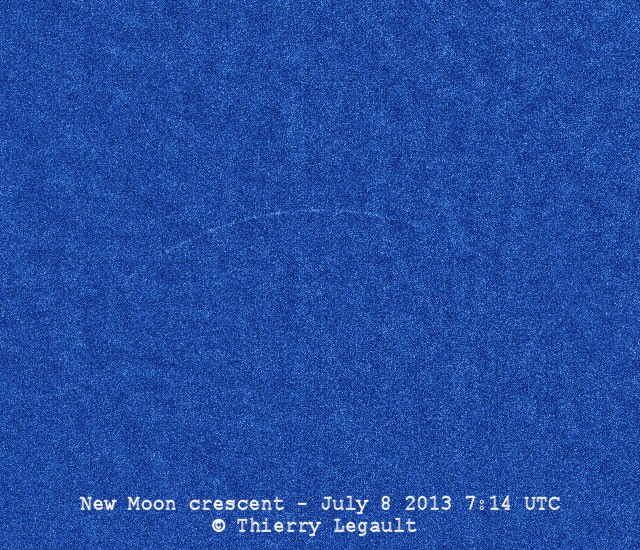It’s always striking to see a tiny sliver of the New Moon. But you’ve probably never seen a sliver this tiny or a Moon this “new” before. This brand new image by astrophotographer extraordinaire Thierry Legault was taken this morning and is the youngest possible lunar crescent, with the “age” of the Moon at this instant being exactly zero — at the precise moment of the New Moon. The image was taken in full daylight at 07:14 UTC on July 8, 2013.
Normally it is just about impossible (and dangerous) to see this, as when the Moon is this “new,” the Moon is between the Earth and the Sun and it is so close to the Sun in our sky that it can’t be seen because of the Sun’s glare. Plus, the New Moon appears as an extremely thin crescent which is barely brighter than the blue sky. But Thierry has designed a special sunshade to prevent sunlight from entering the telescope (see it below).
Thierry says the irregularities and discontinuities seen in the edge of the crescent are caused by the relief at the edge of the lunar disk; i.e. mountains and craters on the Moon. Very cool!
The “New Moon” is defined as the instant when the Moon is at the same ecliptic longitude as the Sun. When we refer to the “age” of the Moon, it is the number of hours (or days) since New Moon.
From Thierry’s shooting site in Elancourt, France (a suburb of Paris), the angular separation between the Moon and the Sun was only 4.4° (nine solar diameters).
“At this very small separation, the crescent is extremely thin (a few arc seconds at maximum) and, above all, it is drowned in the solar glare, the blue sky being about 400 times brighter than the crescent itself in infrared (and probably more than 1000 times in visible light),” Thierry writes on his website. “In order to reduce the glare, the images have been taken in close infrared and a pierced screen, placed just in front of the telescope, prevents the sunlight from entering directly in the telescope.”

Thierry cautions anyone trying to see this with the naked eye. Basically, don’t try it.
“The very thin crescent of the New Moon cannot be observed visually whatever the instrument (naked eye, binoculars, telescope, etc),” he said. “Moreover, pointing a celestial object that close to the Sun is dangerous for the observer and his equipment if it is not performed under the control of an experienced astronomer and with the proper equipment.”
See more information at Thierry’s website. He also took another image of the New Moon at the exact moment back in 2010.
If you want to keep track of what the Moon will look like each night (or day!), Universe Today has a great app for that, our Phases of the Moon app, available for iOS or Android.


While a new record photographically, the visual record which I believe is 13.5h still remains. Correct me if this has been beaten….
Bravo!
Amazing. Thierry doesn’t quit amazing me.
He is the man! Real amazing. I used a photo of him (with permission of course) of the moon at age 4 hours, which seems a very big moon 🙂 . Well he broke his own record! Amazing.
That is just gobsmacking. I imagine he will be trying to lower the angular separation for the next one.